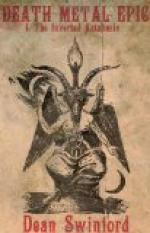“And armed with these, beyond a
doubt,
Shall Rama put those fiends to rout.”
The hermit also beguiled the weariness of their long journey to the forest by relating to Rama the story of the Ganges, the sacred stream of India. We are told that a virtuous king, being childless, betook himself to the Himalayas, where, after spending a hundred years in austerities, Brahma announced he should have one son by one of his wives and sixty thousand by the other, adding that his consorts might choose whether to bear one offspring or many. Given the first choice, the favorite wife elected to be the mother of the son destined to continue the royal race, while the other brought into the world a gourd, wherein a hermit discovered the germs of sixty thousand brave sons, all of whom, thanks to his care, grew up to perform wonders in behalf of their father and brother.
On one occasion, a horse chosen for sacrifice having been stolen, the father despatched these sixty thousand braves in quest of it, and, as they were not able to discover any traces of it on earth, bade them dig down to hell. Not only did they obey, but continued their search until they struck in turn the four elephants on whose backs the Hindus claim our earth peacefully reposes. Here the diggers disturbed the meditations of some god, who, in his anger, burned them up. The poor father, anxious to purify the ashes of his dead sons, learned he would never be able to do so until the Ganges—a river of heaven—was brought down to earth. By dint of penance and prayer, the bereaved parent induced Vishnu to permit this stream—which until then had only flowed in heaven—to descend to earth, warning the king that the river, in coming down, would destroy the world unless some means were found to stem the force of its current. Our clever rajah obviated this difficulty by persuading the god Siva to receive the cataract on the top of his head, where the sacred waters, after threading their way through his thick locks, were divided into the seven streams which feed the sacred springs of India. Thus safely brought to earth, the Ganges penetrated to hell, where it purified the ashes of the sixty thousand martyrs, and ever since then its waters have been supposed to possess miraculous powers.
For sin and stain were banished thence,
By the sweet river’s influence.
The hermit also told how the gods procured the Water of Life (Amrita) by churning the ocean, saying they used Mount Meru as a dasher, and a huge serpent as the rope whereby to twirl it around.
Led by this hermit, Rama not only slew the ravaging monsters, but went on to take part in a tournament, where King Janak offered his daughter, Sita, in marriage to any archer who would span a bow he had obtained from Siva. On arriving at the place where this test was to be made, Rama saw the huge bow brought forth on a chariot drawn by five thousand men, and, although no one else had even been able to raise it, took it up and bent it until it broke with a crack which terrified all present. By this feat young Rama won the hand of Sita, a beautiful princess, whom her father turned up from the soil while ploughing one day, and who is hence the Hindu personification of Spring.




